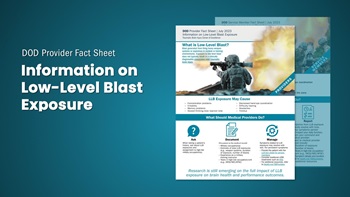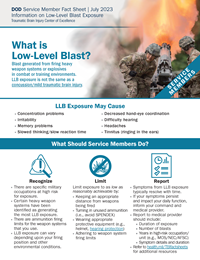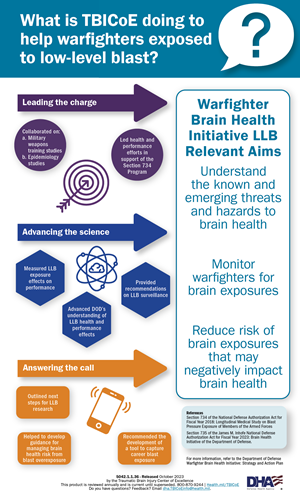Health care providers across the DOD and the VA and service members should be aware of the potential effects of low-level blast exposure and which occupations and heavy weapon systems are associated with increased risk of LLB exposure. Research is still emerging on the full impact of LLB exposure on brain health and performance outcomes.
What Is Low-Level Blast?
Blast generated from firing heavy weapon systems or explosives in combat or training environments. Exposure to low-level blast does not typically result in a clinically diagnosable concussion/mild traumatic brain injury. Exposure does not equal injury!
Does your patient work with heavy weapons systems, explosives, or both, and complain of:
- Concentration problems
- Difficulty hearing
- Headaches
- Memory problems
- Slowed thinking or reaction times
- Decreased hand-eye coordination
They could be experiencing symptoms from low-level blast exposure. Download our new fact sheet and learn how to best document, manage, and care for your patients—to optimize warfighter brain health.


Does your military occupation involve working with heavy weapon systems that leave you feeling unwell or not like yourself? You could be experiencing the effects from low-level blast exposure.
Symptoms from low-level blast exposure usually resolve with time. Learn more about how you can recognize, limit, and report your low-level blast exposure with our new fact sheet.
Service Member Fact Sheet
We've designed an infographic to help illustrate some of the research work being done to better understand how low-level blast influences warfighter brain health. These efforts directly support Line of Effort 2 of the Warfighter Brain Health Initiative.

Download the Infographic
References that Support the Infographic
- Section 734 of the National Defense Authorization Act for Fiscal Year 2018: Longitudinal Medical Study on Blast Pressure Exposure of Members of the Armed Forces
- Section 735 of the James M. Inhofe National Defense Authorization Act for Fiscal Year 2023: Brain Health Initiative of the Department of Defense.
References and Acknowledgements
These fact sheets were developed by a TBICoE core working group, based on the current state of the science on the effects of low-level blast exposure from the use of heavy weapon systems or explosives. A list of refences can be viewed here.
Additionally, the development of these fact sheets was supported by inputs from an end-user working group of providers and service members who were experienced in the use of these weapon systems. The TBICoE team wishes to acknowledge the contributions of the members of the end-user working group, listed below, and express our sincere gratitude. Many thanks.
Expand for full list of references and acknowledgements.
References
- Belding JN, Egnoto M, Englert RM, Fitzmaurice S, Thomsen CJ. Getting on the Same Page: Consolidating Terminology to Facilitate Cross-Disciplinary Health-Related Blast Research. Front Neurol. 2021;12:695496.
- Belding JN, Englert R, Bonkowski J, Thomsen CJ. Occupational Risk of Low-Level Blast Exposure and TBI-Related Medical Diagnoses: A Population-Based Epidemiological Investigation (2005-2015). Int J Environ Res Public Health. 2021;18(24):12925
- Belding, JN, Jackson R, Englert R, et al. Blast Exposure, Traumatic Brain Injury, and Self-Reported Symptomology Among Active Duty Enlisted Marines: An Examination of Post-Deployment Health Assessment Records, 2005-2012. Naval Health Research Center, San Diego, CA, US, 2020.
- Boutté AM, Thangavelu B, LaValle CR, et al. Brain-related proteins as serum biomarkers of acute, subconcussive blast overpressure exposure: A cohort study of military personnel. PLoS One. 2019;14(8):e0221036.
- Carr W, Polejaeva E, Grome A, et al. Relation of repeated low-level blast exposure with symptomology similar to concussion. J Head Trauma Rehabil. 2015;30(1):47-55.
- Carr W, Kelley AL, Toolin CF, Weber NS. Association of MOS-Based Blast Exposure With Medical Outcomes. Front Neurol. 2020;11:619.
- Gill J, Cashion A, Osier N, et al. Moderate blast exposure alters gene expression and levels of amyloid precursor protein. Neurol Genet. 2017;3(5):e186.
- Haran FJ, Zampieri C, Wassermann EM, et al. Chronic Effects of Breaching Blast Exposure on Sensory Organization and Postural Limits of Stability. J Occup Environ Med. 2021;63(11):944-950.
- Haran FJ, Handy JD, Servatius RJ, Rhea CK, Tsao JW. Acute neurocognitive deficits in active duty service members following subconcussive blast exposure. Appl Neuropsychol Adult. 2021;28(3):297-309.
- Kamimori GH, LaValle CR, Eonta SE, Carr W, Tate C, Wang KKW. Longitudinal Investigation of Neurotrauma Serum Biomarkers, Behavioral Characterization, and Brain Imaging in Soldiers Following Repeated Low-Level Blast Exposure (New Zealand Breacher Study). Mil Med. 2018;183(suppl_1):28-33.
- LaValle CR, Carr WS, Egnoto MJ, et al. Neurocognitive Performance Deficits Related to Immediate and Acute Blast Overpressure Exposure. Front Neurol. 2019;10:949.
- Modica CM, Johnson BR, Zalewski C, et al. Hearing Loss and Irritability Reporting Without Vestibular Differences in Explosive Breaching Professionals. Front Neurol. 2020;11:588377.
- Modica LCM, Egnoto MJ, Statz JK, Carr W, Ahlers ST. Development of a Blast Exposure Estimator from a Department of Defense-Wide Survey Study on Military Service Members. J Neurotrauma. 2021;38(12):1654-1661.
- Skotak M, LaValle C, Misistia A, Egnoto MJ, Chandra N, Kamimori G. Occupational Blast Wave Exposure During Multiday 0.50 Caliber Rifle Course. Front Neurol. 2019;10:797.
- Thangavelu B, LaValle CR, Egnoto MJ, Nemes J, Boutté AM, Kamimori GH. Overpressure Exposure From .50-Caliber Rifle Training Is Associated With Increased Amyloid Beta Peptides in Serum. Front Neurol. 2020;11:620.
- Wang Z, Wilson CM, Mendelev N, et al. Acute and Chronic Molecular Signatures and Associated Symptoms of Blast Exposure in Military Breachers. J Neurotrauma. 2020;37(10):1221-1232.
- Woodall JLA, Sak JA, Cowdrick KR, et al. Repetitive Low-level Blast Exposure and Neurocognitive Effects in Army Ranger Mortarmen. Mil Med. 2023;188(3-4):e771-e779.
- Vartanian O, Coady L, Blackler K, Fraser B, Cheung B. Neuropsychological, Neurocognitive, Vestibular, and Neuroimaging Correlates of Exposure to Repetitive Low-Level Blast Waves: Evidence From Four Nonoverlapping Samples of Canadian Breachers. Mil Med. 2021;186(3-4):e393-e400.
Acknowledgements
| End-User Working Group |
TBICoE Core Working Group |
| Timothy Camasta, PA-C |
Ida Babakhanyan, PhD |
| Sean Clerkin, SSG, USA |
Casey Becker, BSN, RN, CBIS |
| Kaarin Coe, LCSW, BCD, CDR, USN |
Lori Dickerson-Odoms, PMP |
| Dennis L. Doan, EODCS, Navy (Ret) |
Amanda Gano, PA-C, MPH, MS |
| Aaron Foist, DEVCOM EOD, MAJ, USA |
Joanne Gold, PharmD, BCGP |
| Collin Hu, DO, FAAFP, Maj, SFS, USA |
Rachael Kaufman, OTR/L, MS, CBIS |
| Andrew Jansen, SFC, EOD, USA |
Donald Marion, MD, MSc |
| Jie Liu, MD |
Stephanie N. Maxfield Panker, PT, PhD, DPT |
| Maya Lowell, PA-C, Maj, USA |
Gary McKinney, DHSc, CBIS, CPT |
| Greg Miller, MD, Maj, USAR |
Elizabeth Pletcher, MSW, LSW, PMP |
| M. Cole Pasley, CMSgt, USAF |
Miriam Roth, PA-C, MS, DPA |
| Rebecca Rausa, PA-C, LCDR, USN |
Keith Stuessi, MD |
| Dominique Rhymes, SCPO, EOD, USN |
Stephanie Turner, MS |
| William Rice, MD, MPH, MHA, FACOEM |
|
| Amanda Robbins, PsyD, MS, LTC, USA |
|
You also may be interested in...